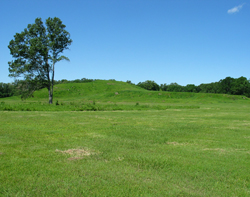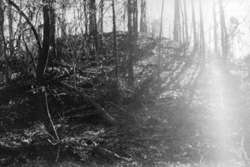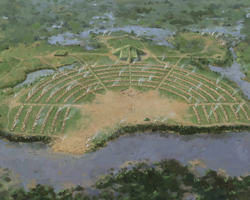Introduction to Delta Pieces: Northeast Louisiana Folklife
Map: Cultural Micro-Regions of the Delta, Northeast Louisiana

The Louisiana Delta: Land of Rivers








Ethnic Groups










Working in the Delta








Homemaking in the Delta



Worshiping in the Delta



Making Music in the Delta




Playing in the Delta







Telling Stories in the Delta



Delta Archival Materials
Bibliography

Ouachita River Mounds: A Five Millennium Mystery
By Lori Tucker
In northeastern Louisiana, where the Louisiana Folklife Festival gathers "the tribes" today, hunters-and-gatherers established a tradition of moundbuilding that began five millennia ago and continued until the arrival of Europeans. The earthworks they built are striking evidence of Louisiana's earliest residents. They also are a testimony to the complexity of an ancient culture that remains largely a mystery.
What we understand about the moundbuilders is changing as a result of research in the last decade. Previously, researchers, influenced by modern studies of San hunter-gatherers in Africa, have assumed the small, mobile bands that inhabited the southeastern U.S. 5,000 years ago didn't have the social structure necessary for major earthworks. Now, research at numerous sites confirms that people who had not yet cultivated plants or learned how to make pottery had the engineering skills to build impressive earthworks as well as the ability to work together to complete labor-intensive projects.
The massive earthworks at Poverty Point near Epps were long considered the beginning of extensive mound construction. Non-native stones found on the site originated as far away as Wisconsin, Tennessee, and Georgia indicate that Poverty Point was a major trade center circa 1500 BC. The Poverty Point culture spread over a large part of the Lower Mississippi Valley and flourished from around 1730 BC to 1350 BC. Until recently, Poverty Point was considered an amazing anomaly because no one had identified significant earlier sites.
In the early 1990s, Joe Saunders began to test the theory that Poverty Point was the oldest mound complex. Saunders is regional archaeologist for the Division of Archaeology in the Louisiana Department of Culture, Recreation and Tourism. He obtained calibrated radiocarbon dates from several sites including Hedgepeth, Frenchman's Bend, and Watson Brake that placed their construction between 3700 BC and 3000 BC. Saunders and others now have reason to believe that mound construction was widespread by 3000 BC in northern and southern Louisiana as well as Mississippi and Florida where other researchers have worked for years. Reca Bamburg Jones was instrumental in bringing Watson Brake to Saunders' attention. She grew up near the mounds, located about 20 miles southwest of Monroe. Like other local residents, she always knew about the mounds, but only three were clearly identifiable in the thick woods. Jones made a mid-life decision to pursue archaeology in earnest as a hobby in the early 1980s. She enrolled in every archaeology course she could at the University of Louisiana at Monroe. In 1981, logging operations revealed more of the landscape at the mounds than before. Jones studied the site and was the first to decipher the pattern of 11 mounds connected by ridges that form a circle roughly 280 yards across. The largest one is a steep-sloped 25-foot tall mound that overlooks a low swampy area. In 1983, John Belmont and Jones published the site in a survey of prehistory in the Ouachita River Valley. By the time Jones showed the site to Saunders, it once again was mostly hidden by thick forest. Saunders enlisted Thurman Allen, a soil scientist with the USDA Natural Resources Conversation Service, to assist in determining the age of the site. When Allen obtained a core sample of the largest mound, he found advanced soil development. Saunders then decided the site was worth further study. Radiocarbon dating of Watson Brake places its construction in a 400-year period beginning at 3400 B.C. Watson Brake became a focal point of research into Middle Archaic mounds because it is larger, more securely dated and has been disturbed less than the others. In September, 1997, Saunders and an interdisciplinary team of scientists published their findings about Watson Brake in Science, presenting evidence that Middle Archaic hunter-gatherers constructed monumental architecture at Watson Brake and lived there on a seasonal basis.
Though many aspects of life for the ancient moundbuilders remain a mystery, Tom Eubanks, State Archaeologist with the Division of Archaeology, said a look at Louisiana today provides some insight. The wetlands and streamed valleys that provide a habitat for wild game sought by today's hunters also provided food for people long ago. From streams and rivers, they gathered mussels and snails for food. They also captured many of the same fish that Louisiana's sportsmen enjoy today, freshwater drum, white perch, largemouth bass, bream, and catfish. Though at Watson Brake the site's food remains are mostly aquatic, bones found in the midden show that people also ate deer, turkey, raccoon, opossum, squirrel, and rabbits. Though modern Louisiana residents savor crawfish, apparently the ancient moundbuilders did not. Eubanks said the first people entered the Lower Mississippi Valley about 10,000 BC. These Paleo-Indians lived in small nomadic groups that followed wild game and lived in temporary shelters made of branches, grass and hide. They left few artifacts in any one location that would survive the humid climate. Since the sea level was lower than today, some of the state's earliest sites probably are under water or buried by the alluvial soils along the rivers, Eubanks said.
By the occupation of the Poverty Point site, culture had changed dramatically. No other earthworks in Louisiana compare in size to Poverty Point, which covers more than a square mile. In its time, it was the largest set of earthworks in the Western Hemisphere. Earthen ridges form six semicircles, one inside the other, that are interrupted by five aisles radiating from a broad flat center. Robert Connolly, former Poverty Point station archaeologist, says it was long assumed that the plaza at Poverty Point was naturally flat and may have attracted people to build there. Connolly said archaeologists now know that what looks like a natural plaza was once a large gully that people filled up with garbage and dirt. The Poverty Point culture flourished for more than 1,000 years, but had virtually disappeared by 600 BC. The reason for the decline isn't known, but Eubanks said after Poverty Point people lived in smaller, scattered communities they continued to build mounds.
Tristam Kidder, associate professor of anthropology at Tulane University, said the archaeological sites found along the Ouachita River are both typical of those found elsewhere in the southeastern United States and also unique. They are unique in that they are older, but the earlier sites are more or less similar to the rest of the southeast in general characteristics, Kidder said.
Later, regional differences, such as the style of design on pottery, are evident. After 500 BC, archaeological evidence shows that the people in the Ouachita River Valley had a different culture than those in the Mississippi and Red River valleys though they were connected by trade, Kidder said. The purpose of the earliest mounds remains a matter of speculation, but it's evident that over time their function changed. None of the mounds at Watson Brake or Poverty Point are considered burial mounds. By the time of the Marksville Culture in the second century BC, some of the mounds were used for burials. The development of the Marksville Culture was another cultural shift. People at the Marksville site in Avoyelles Parish used images on their pottery similar to those of the Hopewell culture in the Ohio Valley.
As the climate changed, people began to diversify their economies. In northwestern Louisiana, the ancestral Caddo Indians built their economy on corn. In South Louisiana, the ancestral Chitimacha developed fisheries. The latest shift in archaeologists' views on the advent of moundbuilding raises new questions about the people who lived off the rich resources of Louisiana in Middle Archaic times, but Saunders said he plans to leave many of those questions for others to answer. Saunders compares his role to that of a carpenter who frames a house and leaves the finishing to another carpenter whose skills are better suited for the detail work. He said it's time for people to look at the site from different views and angles than his own.
Eubanks said now that a group of sites have been recognized as older than Poverty Point, the state would like to develop Watson Brake as a state commemorative area. Poverty Point and Marksville already are state commemorative areas, open to the public with interpretative museums and programs and also with ongoing research. At this time, however, Watson Brake site is not open to the public. The Archaeological Conservancy purchased half of the site in 1996 and later sold it to the state in an effort to preserve it. The other half is privately owned. The master plan of the Office of State Parks is to develop a series of sites representing different times in prehistory. The Ancient Mounds Heritage Area and Trails Advisory Commission, created by the legislature in 1997, is charged with identifying representative sites for this purpose. It will take many generations of archaeologists and researchers from related disciplines to decipher the mysteries of Louisiana's moundbuilders.






